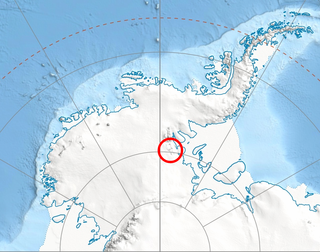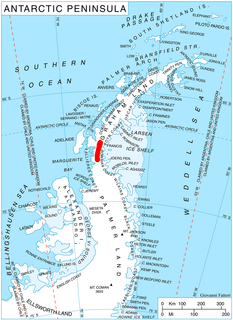
The Patuxent Range or macizo Armada Argentina is a major range of the Pensacola Mountains, comprising the Thomas Hills, Anderson Hills, Mackin Table and various nunataks and ridges bounded by the Foundation Ice Stream, Academy Glacier and the Patuxent Ice Stream. Discovered and partially photographed on January 13, 1956 in the course of a transcontinental nonstop plane flight by personnel of U.S. Navy Operation Deep Freeze I from McMurdo Sound to Weddell Sea and return.

The Prince Charles Mountains are a major group of mountains in Mac. Robertson Land in Antarctica, including the Athos Range, the Porthos Range, and the Aramis Range. The highest peak is Mount Menzies. Other prominent peaks are Mount Izabelle and Mount Stinear. These mountains together with other scattered peaks form an arc about 260 miles long, extending from the vicinity of Mount Starlight in the north to Goodspeed Nunataks in the south.

Dufek Massif is a rugged, largely snow-covered massif 27 nautical miles (50 km) long, standing west of the Forrestal Range in the northern part of the Pensacola Mountains. It was discovered and photographed on January 13, 1956 on a transcontinental patrol plane flight of U.S. Navy Operation Deep Freeze from McMurdo Sound to the vicinity of the Weddell Sea and return, and named by the Advisory Committee on Antarctic Names for Rear Admiral George J. Dufek, U.S. Navy, who was in direct operational command of U.S. Navy Task Force 43 during that operation. The entire Pensacola Mountains were mapped by the U.S. Geological Survey in 1967 and 1968 from ground surveys and U.S. Navy tricamera aerial photographs taken in 1964.
The Lawson Nunataks are a line of nunataks about 4 nautical miles (7 km) long, located 4 nautical miles southwest of Keim Peak in the Usarp Mountains of Antarctica. They were mapped by the United States Geological Survey from surveys and U.S. Navy air photos, 1960–62, and named by the Advisory Committee on Antarctic Names for Gerald J. Lawson, a United States Antarctic Research Program biologist at McMurdo Station, 1967–68.
The McCuddin Mountains is a small cluster of mountains in Antarctica consisting mainly of two large mountains, Mount Flint and Mount Petras, along with several scattered peaks and nunataks. Located in Marie Byrd Land, 64 km (40 mi) east of the Ames Range. The mountains were discovered and photographed from the air in a flight from West Base of the U.S. Antarctic Service on Dec. 14, 1940. They were mapped by U.S. Geological Survey (USGS) from surveys and U.S. Navy air photos, 1959-65. Named by Advisory Committee on Antarctic Names (US-ACAN) for Rear Admiral Leo B. McCuddin, U.S. Navy (USN), Commander of the U.S. Naval Support Force, Antarctica, 1972.
Bingham Peak is a sharp peak, 1,540 metres (5,050 ft) high, located 2.5 nautical miles (5 km) southeast of Springer Peak in the Heritage Range, Ellsworth Mountains. It was mapped by the United States Geological Survey from ground surveys and from U.S. Navy air photos, 1961–66, and named by the Advisory Committee on Antarctic Names for Joseph P. Bingham, an auroral scientist at Eights Station in 1965.

The Gothic Mountains is a group of mountains, 32 kilometres (20 mi) long, in the Queen Maud Mountains of Antarctica, located west of Watson Escarpment and bounded by Scott Glacier, Albanus Glacier, and Griffith Glacier. The mountains were first visited in December 1934 by the Byrd Antarctic Expedition (ByrdAE) geological party led by Quin Blackburn. The name was proposed by Edmund Stump, leader of a U.S. Antarctic Research Program (USARP) - Arizona State University geological party which made investigations here in the 1980-81 season. The mountains are composed of granites which have weathered to produce a series of spires and peaks reminiscent of a Gothic cathedral.
Ovbratten Peak is a steep, pyramidal rock peak about 2 nautical miles (3.7 km) southwest of Hogfonna Mountain, in the Borg Massif of Queen Maud Land. Mapped by Norwegian cartographers from surveys and air photos by Norwegian-British-Swedish Antarctic Expedition (NBSAE) (1949–52) and named Ovbratten.
The Jule Peaks are a small group of isolated peaks located about 35 nautical miles (65 km) west-northwest of Borg Mountain in Queen Maud Land, Antarctica. They were mapped by Norwegian cartographers from surveys and air photos by the Norwegian–British–Swedish Antarctic Expedition (1949–52), and named Juletoppane. The Annandags Peaks sit about 15 nautical miles southwest.
Gatlin Peak is a prominent but somewhat detached snow-covered peak, rising 4.5 nautical miles (8 km) northeast of Steel Peak at the northeast end of the Welch Mountains, in Palmer Land, Antarctica. It was mapped by the United States Geological Survey in 1974, and was named by the Advisory Committee on Antarctic Names for Lieutenant Donald H. Gatlin, U.S. Navy Reserve, a navigator on LC-130 aerial photographic flights during Operation Deep Freeze 1968 and 1969.

Goettel Escarpment is a prominent escarpment buttressing the Dyer Plateau located 5 nautical miles (9 km) north of Orion Massif and near the head of Chapman Glacier in Palmer Land.
Lockley Point is a low, ice-covered point lying 1 nautical mile (2 km) northeast of Noble Peak on the northwest side of Wiencke Island, in the Palmer Archipelago, Antarctica. It was discovered by the Belgian Antarctic Expedition under Gerlache in 1898. The point was resighted and charted by the Falkland Islands Dependencies Survey in 1944, and named for Lieutenant J.G. Lockley, Royal Naval Volunteer Reserve, base leader, biologist, and meteorologist at Port Lockroy in 1945.

Henderson Glacier is a glacier about 7 nautical miles long in the Enterprise Hills of the Heritage Range, Antarctica. It flows northeast from Schoeck Peak and Hoinkes Peak to enter Union Glacier just east of Mount Rossman. Henderson Glacier was mapped by the United States Geological Survey from surveys and U.S. Navy air photos 1961–66, and was named by the Advisory Committee on Antarctic Names for Felix E. Henderson, a United States Antarctic Research Program meteorologist at Eights Station in 1965.
Matheson Glacier is a glacier 11 nautical miles (20 km) long, lying 2 nautical miles (4 km) south of Ashton Glacier, which it parallels, and flowing in an easterly direction to the west side of Lehrke Inlet, on the east coast of Palmer Land, Antarctica. It was first sighted by members of the United States Antarctic Service who explored this coast by land and from the air in December 1940, and was first charted by a joint party consisting of members of the Ronne Antarctic Research Expedition and Falkland Islands Dependencies Survey (FIDS) in 1947. The glacier was named by the FIDS for J. Matheson, a member of the FIDS at the Port Lockroy and Hope Bay bases, 1944–46.

Klebelsberg Glacier is a glacier, 7 nautical miles (13 km) long and 2 nautical miles (4 km) wide, situated at the south side of Finsterwalder Glacier and flowing from Hemimont Plateau northwestward between Armula Peak and Smilyan Bastion on Graham Land, Antarctica, toward the head of Lallemand Fjord. With Finsterwalder Glacier and Haefeli Glacier, its mouth merges with Sharp Glacier where the latter enters the fjord. It was first surveyed from the plateau in 1946–47 by the Falkland Islands Dependencies Survey, and named by them for Raimund von Klebelsberg, an Austrian glaciologist.
The Mayer Crags form a rugged V-shaped massif in Antarctica. The feature is 10 nautical miles (19 km) long, surmounted by several sharp peaks, and located at the west side of the mouth of Liv Glacier, where the latter enters the Ross Ice Shelf. It was named by the Advisory Committee on Antarctic Names for Lieutenant Robert V. Mayer, U.S. Navy, a pilot of Hercules aircraft in four Antarctic seasons, and plane commander for a mid-winter evacuation flight on June 26, 1964.
Taurus Nunataks is a line of three nunataks running east-west, with only the outer two of any prominence, located 23 nautical miles (43 km) east-northeast of Gurney Point in Palmer Land. Named by United Kingdom Antarctic Place-Names Committee (UK-APC) after the constellation of Taurus.

Pulpudeva Glacier is the 4.6 nautical miles long and 3.2 nautical miles wide glacier in Sullivan Heights, Sentinel Range in Ellsworth Mountains, Antarctica. It is draining the area northeast of Nebeska Peak, north of Johnson Col and northwest of Mount Farrell, flowing northwards west of Mount Levack, and joining Ellen Glacier northwest of Mamarchev Peak and southeast of Mount Jumper.

Padala Glacier is the 5.6 nautical miles long and 2.4 nautical miles wide glacier in Bangey Heights on the east side of the main ridge of north-central Sentinel Range in Ellsworth Mountains, Antarctica. It is situated northwest of Kopsis Glacier and east-southeast of Marsa Glacier. The glacier drains the northeast slopes of Bezden Peak and the southeast slopes of Golemani Peak, flows northeastwards and joins Embree Glacier northwest of Mount Hleven.











